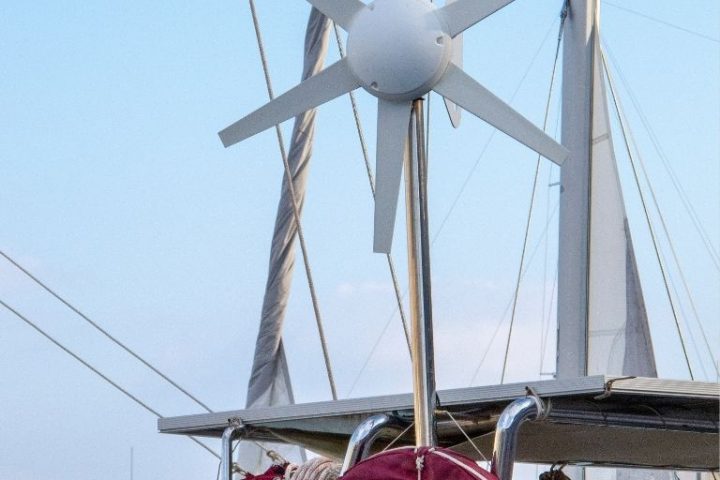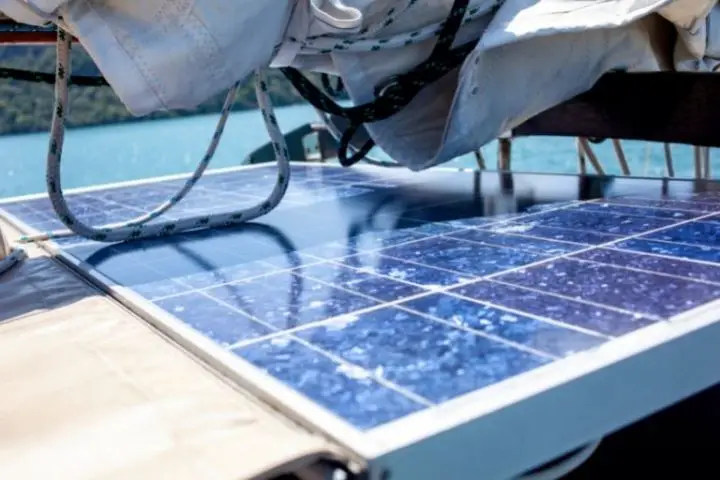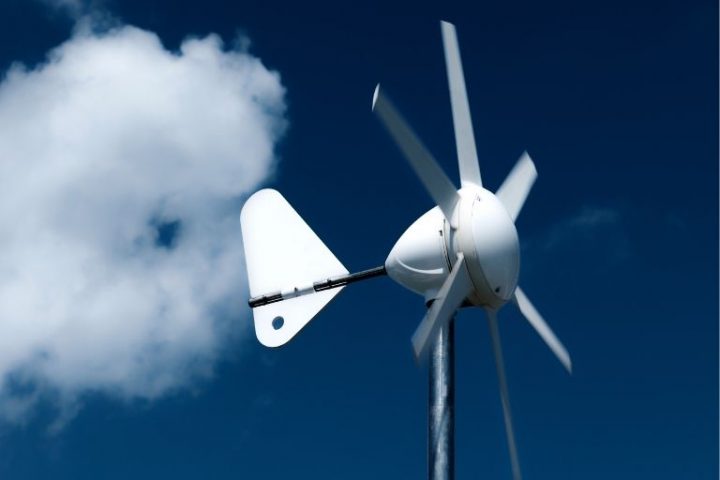Nothing denotes a salty off-the-grid ready yacht more than the sight of a wind generator mounted on the stern. Once, these were the main component of a sailor’s renewable energy arsenal.
But today, as is the case with wind generators for RVs, the technology has fallen behind the fantastic strides that solar panels have made. Today’s solar panels are less expensive and more efficient than ever before, while wind generator technology hasn’t progressed much in the last 50 years.
Still, there are limited times when wind generators make the most sense on sailboats. Here’s a look at who could benefit from one and five of the best options on the market.
Table of Contents
- Is a Wind Generator Right for Me?
- How Much Power Do I Need?
- Alternatives to Wind Power
- Things to Look for in a Marine Wind Generator
- 5 Great Marine Wind Generators
Is a Wind Generator Right for Me?
Before you dive into the whirlwind of information out there about marine wind generators, take a step back for a reality check. Wind generators were the standard-bearer for years onboard sailboats, but in the 21st century, their usefulness has all but been replaced by solar panels. Solar is efficient, silent, and completely maintenance-free.
As a result, the usefulness of a wind generator is now much more limited. There are many pros for wind generators—but most of them can be negated by one simple fact–the amount of usable power they produce is significantly less and more expensive than solar.
Furthermore, the two times when a wind generator does make sense are not conditions typically encountered by most cruisers. Wind generators are only effective for significant power when the apparent wind speed on deck is more than 15 knots. That’s apparent wind speed on deck—meaning most downwind sailing in winds less than 22 knots true or so would be out.
And then there are anchorages, where sailors hope that a wind generator will help them live off-the-grid to avoid a generator or engine recharge. How many anchorages have you recently sat in that had a constant 15 to 20 knots of undisturbed wind blowing through them? Most of the time, we’re trying to get out of conditions like that, not anchor in them.
There are some parts of the world where these conditions are the norm. Caribbean trade winds and high latitude winds make wind generators more attractive. Those sailors stuck in the “horse latitudes” in between will find their wind generators silent and motionless most of the year.
The other time that adding a wind generator makes sense is when there is simply no other renewable energy option available. A wind generator can mount in many ways on nearly any type of sailboat. It has a tiny footprint, unlike a large solar array.
The bottom line is this—only add wind power when you have absolutely no space left for solar. If you’re maxed out on solar, a wind generator can give you a little boost. But another solar panel will consistently outperform a wind generator—unless you’re that rare sailor whose anchorages of choice feature steady and uninterrupted 20-25 knot winds.

Pros and Cons of Wind Power for Boats
Pros
- 24-hour per day operation (as long as it’s windy)
- Small installation footprint, compatible with most sailboats
- Good options when solar panels cannot be used due to mounting problems or shading (especially on ketches)
Cons
- Very low power generation in most conditions
- Noisy
- Ugly and bulky, mast and mount included
- Not effective when sailing downwind (like most tradewind sailing)
- Not effective in protected anchorages
- Maintenance intensive, moving parts and bearings wear out
- Limited controller options, many not compatible with LiFePO4 battery systems
- Expensive compared to solar
How Much Power Do I Need?
When calculating your requirements for off-the-grid living, the math does not lie. The problem is not lying when you do the math. You can find many calculators and spreadsheets online to help you make the basic calculations.
First, you need to know precisely how much power every electrical consumer on the boat will use and how long it will run each day. These items are often variable—refrigerators will have to run longer in hot climates and the summer, and lights will burn longer during the dark winter months. For everything that uses electricity, calculate the watts used per day (24-hour period).
Next, you’ll want to take into account how much power is being generated. It’s impossible to get accurate numbers for your setup until you’re out there doing it. In general, solar can be counted on for its maximum output for three or four hours a day. How many sunny days a year depends on your location. Again, there are many calculators online.
The wind is good for 24 hours a day, of course, but the wind is seldom that constant. So when calculating the math for a wind generator, it’s very easy to feel good about the choice. But practice has routinely shown that even a small solar array will outperform it in nearly every location.
Alternatives to Wind Power
As already mentioned, the number one choice for most sailboats for renewable power is solar. Solar panels are inexpensive and last for decades with zero maintenance. The downside is that they require a lot of shade-free space to work best.
For boats looking to make power during offshore passages, hydrogenerators are another solution. As long as the boat is cruising at six knots or more, the water passing by has enough potential energy to run electronics and charge batteries. The Watt & Sea Hydro generator is one of the best options out there, but there are also towable generators that do not require permanent installation. Some boats even have the option to use the free-spinning propulsion propeller to create electricity. Of course, these options only help charge the batteries when the boat is moving under sail, and only then at fast speeds.

Things to Look for in a Marine Wind Generator
Power Output
The first thing to realize is that you must take manufacturer’s ratings for their units with a grain of salt. The numbers are engineering calculations for ideal conditions. That is to say, conditions that a marine wind generator will likely never get to experience.
Of all of the performance numbers worth considering, perhaps the most interesting numbers are those at the low end on the scale – when does the unit start producing power, and how much. Most of us boat in places with 15 knots of wind or less most of the time, so this is the range your wind generator will sit in for most of its serviceable life.
Noise Level
First and foremost – do not be fooled by online reviews. Every wind generator on the market produces noise. Since the noise is generated from multiple sources, it can be hard to compare apples to apples when shopping for a generator.
Blade design has a significant effect on noise – some blades are simply noisier than others. Not only does the blade’s aerodynamics make noise, but they can also cause vibrations. All wind generators will require occasional rebalancing and adjustment to minimize vibrations from the blades.
The moving parts inside the generator can also cause noise. Most are mounted with standard ball bearings that can and do go bad. Many manufacturers advertise these as maintenance-free, but that’s simply unrealistic in the marine environment.
Finally, the mount on the boat is a significant source of noise because it transmits the blade’s vibrations, no matter how minor, into the boat’s structure. Proper mounts have rubber dampening pads built-in, but even still, some noise will get through. This can sound like a buzz, hum, or even a thumping noise.
Quality of construction plays a huge part in how much noise a wind generator makes. As a result, you get what you pay for with wind generators. Unfortunately, the inexpensive hardware store models built for residential use are typically the noisiest.
You can compare the noise output of various wind generators by taking a stroll around the marina docks or a dinghy ride around the anchorage. Bad or poorly-maintained wind generators can be heard from many boat lengths distance. On the other hand, a high-quality unit will be difficult to hear when you’re standing under it, much less on another vessel.
Correct Voltage
Wind generators should be matched to your primary battery bank—the one that you’ll be charging. Most boats will be 12 volts, and a few will be 24. 48-volt systems are becoming more popular on electric yachts and those using the battery bank for big consumers like air conditioning. These are the exceptions to the rule, however.
Charge Controller Functions
Unlike solar, wind generators are typically matched to the charge controller that the manufacturer packages with the unit. There are simply a lot more factors that go into regulating a wind generator, including the generation technology it uses and how it brakes or diverts its load.
Charge controllers are either PWM (pulse width modulation) or MPPT (maximum power point tracking). PWM is a less expensive technology, while MPPT controllers are more expensive. In the world of wind generators, which one a controller features is a bit of a toss-up. Some manufacturers swear by MPPT, while others say there is no benefit to the added cost.
Most solar chargers accept a solar input, usually only about 100 watts, though. It’s probably more efficient to run your solar array on its own MPPT charge controller. But if you’re only planning on installing a small array and don’t want the hassle of programming separate charge controllers, having the option with your wind controller is a very nice feature.
Finally, the programmability of the charge controller is a significant factor. Very few of the older PWM charge controllers allow you to input charging profiles. Again, this is less of a problem with wind power than with solar. But if you’re planning to use less forgiving battery chemistries like lithium, you’ll want as much control as you can get from your controller.
Brake and Automatic Cut-Off
Being able to cut a wind generator off in an over-power or over-speed scenario is extremely important. All wind generators come with some form of braking system. The brake needs to be used when the system reaches a full charge, or the wind speed goes beyond the wind generator’s limits.
Remember that the generator’s not simply limited by what the blades and bearings can handle. There is also the strength of its mounts to consider. For example, a 60-knot gust on a free-spinning generator will impose an unbelievable force on its mounts.
Then there are wiring considerations. The wind generator is only designed to output so much power, and during your installation, you must use wire sized for the maximum output. What happens if more than that amount of current goes through wires due to a brake failure? Heat and possible battery damage will result, but hopefully, the circuit breaker or fuse will cut it off before then.
Some have aerodynamic brakes that turn the generator as wind speed increases. This theoretically means that it can never go over its designed limits.
Others feature a brake that is automatically or manually activated. It’s designed to come on when the current reaches a maximum, such as during powerful wind gusts. It also breaks the unit to a stop when the batteries are fully charged.
An alternative plan is to have a diversionary load. Some wind generators will come with dump loads, which are nothing more than ceramic heating elements. When the wind generator produces too much power, power is redirected from the batteries into these heating elements. They’re also used when the generator produces too much power for the system during storms.
Mounting and Unit Weight
The mounting mast used to secure the wind generator is sometimes more complicated than the wind generator itself. It must be strong and stayed from all angles. Stainless tubes with two supports are commonly used to mount them to the back of yachts.
The construction and position of the wind generator are essential to reduce vibrations and noise within the boat. Don’t mount a wind generator over someone’s bunk! All proper mounts have sound-deadening materials like rubber grommets built in to make them as quiet as possible.
The blades of a wind generator must be positioned so that they can’t catch any lines, canvas, or flags from other parts of the boat. This makes stern-rail mounting almost impossible on ketches and yawls. On these boats, mizzen mast mounts are often the best alternative.
Keep in mind as well that the spinning blades of a wind turbine are like spinning knives. Sailors have lost fingers trying to secure wind generators during storms. Therefore, they should be mounted high enough that it is impossible to accidentally come in contact with the blades during normal operations.
As mentioned before, another critical component of the mounting is calculating the correct wire size. This is calculated from the unit’s maximum output, the round-trip length of the wire run, and the unit’s charge voltage.
Finally, the positioning of the wind generator should supply it with uninterrupted airflow. If the wind is blocked, even slightly, but a mast, sail pack, or hardtop, the wind generator’s efficiency will be negatively affected. These items could also induce turbulence into the air being supplied to the turbine, which could result in vibrations and noisy operation.

5 Great Marine Wind Generators
When shopping around for wind generators, notice that power output is not one of our main criteria. This might seem odd, but all of the wind generators on this list produce more or less the same amount of power in a given wind. Some start producing at lower speeds, and some keep producing at high speeds, but in general, these occurrences are so minor and so rare that they don’t calculate into the shopping process.
Eclectic Energy D400
The D400 has a legendary reputation among cruising sailors as the wind generator of choice. It is nearly silent to the point of being very difficult to hear. It is built by Eclectic Energy in the UK, and you can spot its distinctive shape and five-blade design on yachts worldwide.
For all the pluses, there are some detractors from the D400. For one, it is pretty much the most expensive option. It is also the heaviest—it requires a much beefier mount than other options do.
SilentWind Pro
The SilentWind has a few advantages over many other wind generators. For one thing, the included MPPT charge controller features Bluetooth programming via a smartphone or tablet. In addition, you can set many parameters for the charge profile—meaning that it is one of the few wind generators that are at least somewhat compatible with the next generation of lithium marine battery systems.
Compared to the D400, the SilentWind has a more lightweight and compact body. It’s a three-blade design that features blue composite fiber blades. The SilentWind is made in Portugal.
Rutland 1200
Rutland is the wind power branch of the Marlec renewable power company from the UK. Rutland makes a wind range of wind generators for yachts of all sizes. The 1200 is a three-blade generator that features an MPPT controller with a solar input. At 10 knots of wind, it produces about 40 watts of power.
Primus Air Silent X
Primus makes a variety of wind generators from their facility in Colorado. The “top-of-the-line,” so to speak, is the Air Silent X. It’s an upgraded version of their Air X that comes supplied with quieter blades made of distinctive blue carbon fiber.
Superwind 350
The German-made Superwind has a unique overspeed and overcharge protection system—the units feature feathering blades. This is undeniably more complex than many other options on the market. These generators are designed to be installed in grueling conditions where a damaged generator cannot be repaired quickly. Their primary market is aimed at remote telecommunication equipment stations and offshore sailors.

